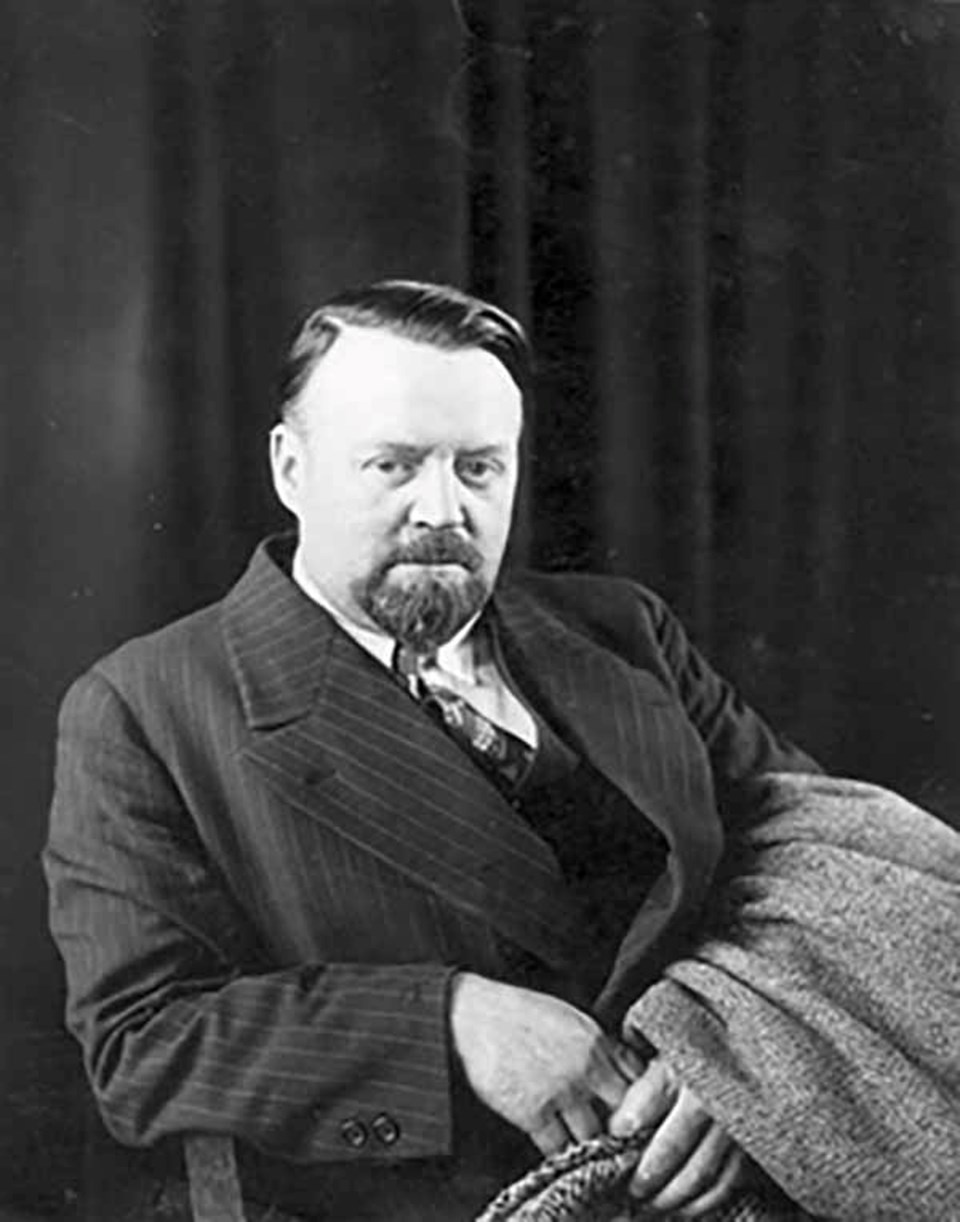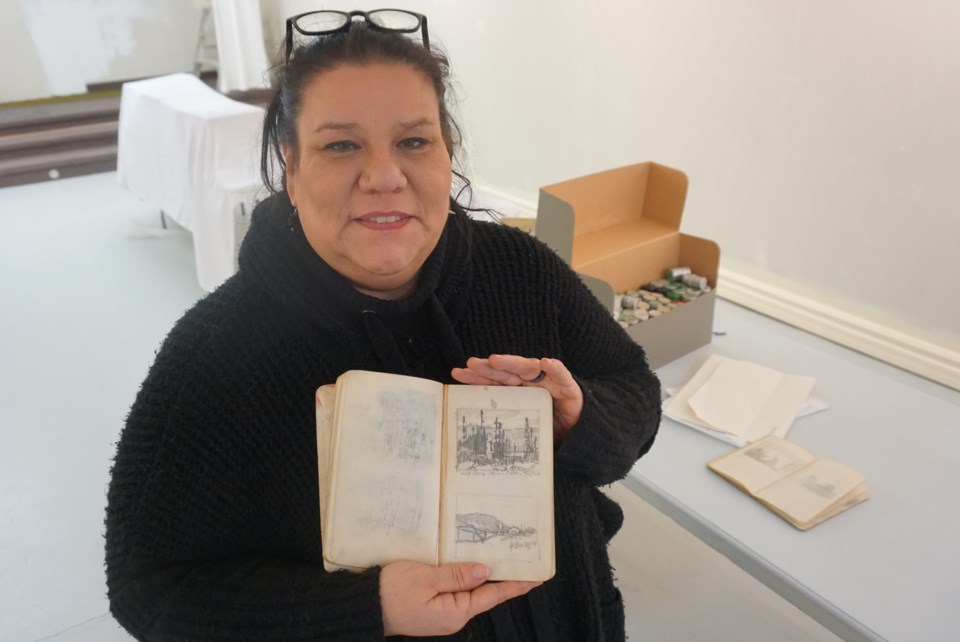Imagine going out to Balm Beach in the Midland area with your family and spotting three members of Canada’s famed Group of Seven sitting not far from where you’ve just set down your towels, beverages and snacks.
Lawren Harris paints on this particular windy day with his white hair brushing his brow, while Arthur Lismer and Franz Johnston sit nearby joking with one another while they create sketches in their small workbooks.
Even non-group members and then little-known artists are there. You’re sure that’s Emily Carr sitting not 10 feet from where your youngest daughter is playing in the sand.
Well, while the year would have been 1926 for this particular special beach day, a short 16-mm film unearthed by avid Huronia Museum volunteer and art enthusiast Christopher Burns captures moments such as these that he discovered while scouring the museum’s extensive Group of Seven collection.
“This is a Midland story,” Burns says of the Group of Seven’s close ties to the area that included Franz Johnston, who had a home on Fifth Street in Midland until his death in 1949.
When he came upon the films and another 8-mm offering that were found in part of a donation by Johnston’s former housekeeper, Burns couldn’t believe what he was viewing.
Watching with museum facility manager Calvin Watts, Burns came away amazed that they were viewing something that, perhaps, no other Canadian had ever seen.
These were home movies of Canada’s famed Group of Seven painting at Balm Beach along with a separate 8-mm film detailing group member and local resident Johnston’s visit to the Northwest Territories in 1936.

There were also pencil sketches in various notebooks with some showing the good humour and fun the members had together, including cartoons by Lismer.
On Saturday afternoon, the museum hosts an official “unboxing” of these impressive finds along with the unveiling of a newly acquired Johnston painting.
As well, guest speaker Michael Janzen will be presenting familiar and unseen Group of Seven and related artists’ artworks from the museum's collection.
While the collection containing the films and photographs came to the museum a number of years ago and was catalogued, it wasn’t until Burns grew more interested in Johnston’s life that the depth of what was there would be discovered.
Burns says he become interested in learning more about Johnston after buying one of his paintings. So he headed over to the museum where he is both a member and volunteer to "dig into the boxes more and more."
Besides the film and sketchbooks that also include work by Lismer, there were also myriad film canisters that have since been developed and show scenes of the group at work and travelling to various Canadian locales along with some lighter moments.
"It's a real treasure trove. We have 15 years of photos he took," says Burns.
And while artists like Johnston were keen to work plein air, he had a health setback so he would often take photos of scenes he might later decide to draw or paint, but "he felt like he was cheating," Burns adds.
Burns says the museum collection is quite simply "exhaustive."
"We have 2,000 to 3,000 photographs taken in Midland, Wyebridge, Quebec and the Northwest Territories," he explains. "We also have letters Johnston wrote to his wife as he travelled the country."
As for the Northwest Territories film, Burns says it all started when a wealthy industrialist commissioned Johnston to come to the Eldorado Mine in Port Radium to paint a portrait of a sled dog.
“This is where all the uranium came from for the Manhattan Project,” Burns explains, noting that besides painting the canine's portrait, Johnston took the time to explore the region and meet its people.
After arriving at the location near Great Bear Lake, Johnston toured the area and recorded some amazing footage.
“This film footage has Inuit people in their traditional garb living traditionally,” he says, noting there was also footage showing the mining operation and a large float plane.
Burns would later surmise that the plane is actually the one Johnston used as his inspiration for Float Plane Coming in for a Landing, which recently sold for $277,250.
“There’s 45 minutes of film footage in Kodachrome colour that no other Canadian has seen,” Burns says. “We also found the 16-mm that’s in really bad shape but appears to be at the Tondakda artist’s camp at Balm Beach.
The camp was established by Johnston and his wife, Florence Jamieson, whose family once owned a cheese shop in Hillsdale.
“This was an artist’s colony,” Burns says, noting the camp featured log cabins and other amenities designed to keep both professional and student artists sated. "They invited artists from all over Canada."
Prior to settling in the area, Johnston was commissioned in 1918 to paint the home-front during the First World War for the Canadian War Memorials Fund. During evenings and weekends, he sketched Ontario's Royal Canadian Air Force training camps including aircraft in various manoeuvres, some of which he developed into paintings.
In the late summer of 1918, he travelled to the wilderness of the Algoma region near Sault Ste. Marie with fellow artists Lawren Harris, J.E.H. MacDonald and art patron Dr. James MacCallum.
In May 1920, a group of painters including Johnston exhibited as the Group of Seven for the first time at the Grange in Toronto and were hailed as developing a truly Canadian movement. He changed his name from Frank to Franz in 1925 because it seemed "more exotic."
Besides Midland and Balm Beach, Johnston and his wife also lived in Wyebridge where they converted a large building into a home.
Huronia Museum executive director Nahanni Born says they're in the process of working to ensure the films are properly preserved while transforming their contents into 4K resolution to ensure generations to come and other Canadians will be able to view the content.
Born says it's through "happenstance that an interested researcher (Burns) and an interested artist (Janzen)" connected with each other to explore the Johnston "treasure trove."
As for Saturday’s event, a portrait of local artist W.J. Wood by Lismer, which has also been recently donated to the museum, will be unveiled as well as a talk by Janzen, an international visual fine artist, who constantly explores and has been inspired by Georgian Bay since he was a child.
Janzen will presents familiar and unseen artworks from the storage of the Huronia Museum collection while also sharing his new insights into the Group of Seven’s Georgian Bay artworks, including Midland’s associate artist W.J. Wood, whom fellow group member A.Y. Jackson referred to as “a genius.”
Janzen was mentored by A.J. Casson, the last living member of the Group of Seven, and artist Warren Luckcock, a Georgian Bay cottage resident who worked with several of the Group of Seven members.
For the past 10 years, Janzen has exhibited, organized, and represented Canadian art at the Grand Palais and the Carrousel de Louvre in Paris, France as well as museums throughout China. He also chairs the International Federation of Art and Artists.
For further information on this event, contact the museum at 705-526-2844 or [email protected].



